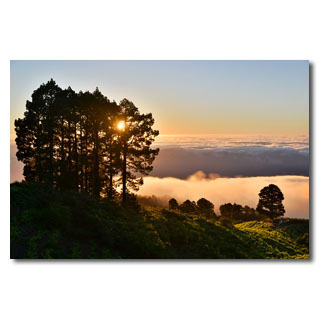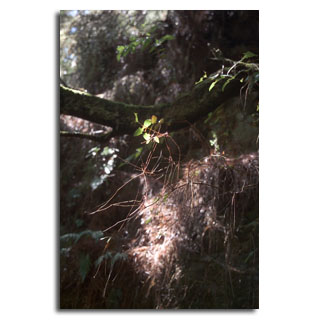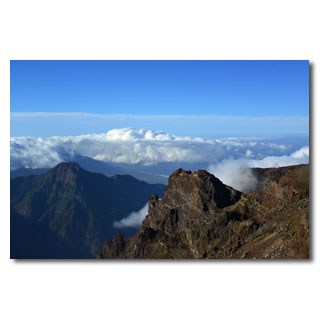Garafía - La Palma's wild north
Garafía extends over the north-west corner of La Palma and delights visitors with its wild landscape, lush green vegetation and secluded forests. The coast here is mostly particularly rough, so that Garafía was hardly accessible for a long time. Only with the construction of the road in the nineties of the last century the municipality became comfortably accessible, before this was only possible on foot, with the donkey or the barge under adventurous conditions. The municipality is divided into the main town of Santo Domingo de Garafía and 12 other villages with between 40 and 300 inhabitants, making it a refuge for those seeking peace and quiet. With its extensive laurel and pine forests, it is an Eldorado for hikers, mountain bikers, marathon runners and people who simply want to relax in the peace and beauty of nature.

Garafía's rugged coast with islets off the coast

The centuries-old dragon trees are particularly popular…

... which is the subject of many legends

Lonely farms and strong swell characterize the community

Nature lovers have always lived here

Historical gofia mill in Hoya Grande

Old royal roads are still in use today as connections between the villages…

... and serve the hikers…

... to explore the island.

Column basalt tells the hiker about the history of La Palma

Today the network of paths is well waymarked and is mostly based on the old 'Caminos Reales'

Partially impenetrable pine forests characterize the landscape

This 'aircraft perspective' high above the clouds…

... fascinates again and again and invites…

... to stay …

... in anticipation of the evening glass of wine that is cultivated here.

Grain was also widely cultivated in the north, and the wild oats are still a silent witness of these times.

Today, however, vine-growing dominates in this rough area.

Often you just can't get away from the spectacle of the sinking…

... sun release, if the evening brings the fog…

... which changes the panorama every second…

... until the red tones…

... be replaced by the darkness of the night.

In this cave in 'La Zarza' once lived the Guanches,…

... natives of La Palma.

Their spiral rock drawings …

... no one has yet deciphered…

... but the sight is fascinating.

Im mystisch wirkenden Lorbeerwald von La Zarza …

... it wouldn't come as a surprise…

... if a fairy…

... a gnome…

...or a troll would see around the corner.

Roque de Los Muchachos
The 'Roque de los Muchachos' at 2.426 m is the highest elevation of La Palma and hosts the most important international observatory of the northern hemisphere. Here is a real high mountain climate, in winter the 'Roque', as the locals call it, is often covered with a snow or ice cap. The observatory is the cause of the only light protection law in the world that exists on La Palma and because of which we are protected from neon or laser advertising. On the Roque you will not only find what is currently (2013) the world's largest reflector telescope with a diameter of 10,40 m; it is also the starting point for many hiking trails through impressive rock formations and the most diverse climatic zones. From the roof of the island you can usually see the neighbouring islands of Tenerife (with Spain's highest mountain, the Teide), as well as La Gomera and El Hierro. A visit is worthwhile at all seasons, in winter, however, you should pay attention to the signs that indicate the obligation to use snow chains if necessary.

The highest point of the Roque - old volcanic vents defying wind and weather

Even closer to the stars - view from the Roque into the Aridane valley…

... to the whole splendour of the Milky Way…

… El Paso …

... or to Polaris and the village El Tablado.

Crystal clear air in the morning sun

The domes of the telescopes, landmarks of the Roque

High-tech in an archaic environment

Changing the watch between the sun and moon

Fastest adjustable reflector telescopes

Landmarks visible from afar, seen from El Tablado

Raging cloud formations

barren high mountain vegetation

View into the Aridane valley

Staggered mountain ranges

Tuff and basalt, building material La Palmas

Columned basalt, once formed at great depths under the sea floor, now at lofty heights.

Cloud falls and rich rock colours

The neighbouring island of Tenerife 'above the clouds'

Botanical experimental fields in the high mountains

And again and again fascinating and rapidly changing wok formations

... enjoy …

... and experience.

View to Breña Alta

The Teide, Spain's highest mountain

The broom glows in the evening sun

Between tree line and vegetation-free zone enchants a broom with bright color

And once again we are above the clouds

© 2012 by Bernd y Nadja Blume. Copias de los textos o fotos, igual que sean digital o imprimido sólo son permitido con la licencia por escrito de los autores.
